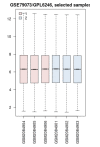Role of Flt4 in Skin Protection against UVB Radiation: A System Biology Approach
- PMID: 33995966
- PMCID: PMC7956040
- DOI: 10.34172/jlms.2020.S5
Role of Flt4 in Skin Protection against UVB Radiation: A System Biology Approach
Abstract
Background: Although the application of ultraviolet B (UVB) in phototherapy of human skin is a common therapeutic method, it is known as a risk factor for skin cancer. This study aims to assess the role of differentially expressed genes (DEGs) to find the critical one that is mainly responsible for skin protection against UVB radiation. Methods: The gene expression profiles of irradiated mice by UVB that issued skin protection against exposure are extracted from Gene Expression Omnibus (GEO) and analyzed by GEO2R. The significant DEGs are assessed via gene ontology (GO) analysis and the critical individuals are investigated via action mapping. Results: Thirty-eight significant DEGs that provide skin resistance against UVB irradiation were determined. Among the query DEGs, 26 individuals were related to 43 biological terms. Flt4, F3, Tspan6, Cblb, and Itgb6 were highlighted as the critical DEGs to promote skin protection against UVB irradiation. Conclusion: The finding indicates that Flt4 is the key DEG that is mainly responsible for protecting skin from UVB exposure.
Keywords: Flt4; Gene ontology; Mouse; Skin; UVB.
Copyright © 2020 J Lasers Med Sci.
Similar articles
-
Assessment of NB-UVB Effects on Skin of Atopic Dermatitis Patients: A Network Analysis.J Lasers Med Sci. 2024 Jul 30;15:e27. doi: 10.34172/jlms.2024.27. eCollection 2024. J Lasers Med Sci. 2024. PMID: 39188927 Free PMC article.
-
Efficacy Evaluation of Treatment of Psoriasis Via Narrow Band-Ultraviolet Radiation.J Lasers Med Sci. 2024 Jul 27;15:e26. doi: 10.34172/jlms.2024.26. eCollection 2024. J Lasers Med Sci. 2024. PMID: 39188934 Free PMC article.
-
Potential molecular characteristics in situ in response to repetitive UVB irradiation.Diagn Pathol. 2016 Nov 10;11(1):129. doi: 10.1186/s13000-016-0579-y. Diagn Pathol. 2016. PMID: 27829444 Free PMC article.
-
Polyphenolic antioxidant (-)-epigallocatechin-3-gallate from green tea reduces UVB-induced inflammatory responses and infiltration of leukocytes in human skin.Photochem Photobiol. 1999 Feb;69(2):148-53. Photochem Photobiol. 1999. PMID: 10048310 Review.
-
Mechanisms of ultraviolet (UV) B and UVA phototherapy.J Investig Dermatol Symp Proc. 1999 Sep;4(1):70-2. doi: 10.1038/sj.jidsp.5640185. J Investig Dermatol Symp Proc. 1999. PMID: 10537012 Review.
References
-
- Ramsay DL, Lish KM, Yalowitz CB, Soter NA. Ultraviolet-B phototherapy for early-stage cutaneous T-cell lymphoma. Arch Dermatol. 1992;128(7):931–3. - PubMed
LinkOut - more resources
Full Text Sources
Miscellaneous



